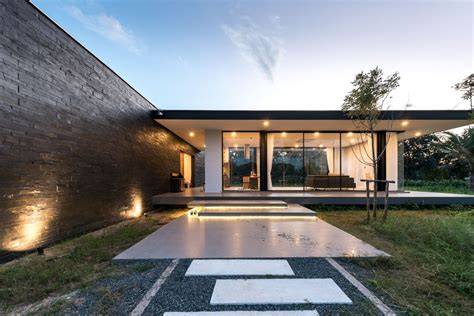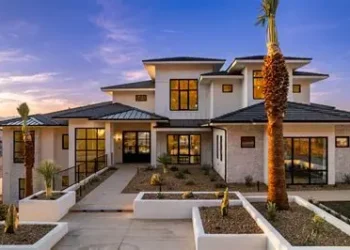As modern flat roof house designs by award winning architects take the spotlight, this introduction invites readers into a realm shaped by expertise, promising a captivating and unique exploration of the subject.
In the subsequent paragraphs, we will delve into the defining characteristics of these designs, the key elements that make them stand out, and the innovative approaches employed by renowned architects.
. Award-winning architects often blur the lines between the interior and exterior of a home by incorporating features like large sliding glass doors, outdoor patios, and rooftop gardens.
This allows residents to enjoy nature and fresh air while still being inside their homes.
Overview of Modern Flat Roof House Designs
Modern flat roof house designs are known for their sleek and minimalist aesthetic, characterized by clean lines, large windows, and open floor plans. These designs often incorporate a seamless connection between indoor and outdoor living spaces, creating a sense of spaciousness and light. Award-winning architects play a crucial role in shaping modern flat roof house designs by pushing the boundaries of traditional architecture and exploring innovative materials and construction techniques. Their expertise and creativity help to create unique and cutting-edge designs that inspire and influence the industry as a whole.Examples of Iconic Modern Flat Roof Houses
- Case Study House 22 (Stahl House) - Designed by Pierre Koenig, this iconic modernist home in Los Angeles features a flat roof, floor-to-ceiling glass walls, and stunning views of the city.
- Fallingwater - Designed by Frank Lloyd Wright, this masterpiece of organic architecture in Pennsylvania showcases a flat roof that blends seamlessly with the natural surroundings.
- Villa Savoye - Designed by Le Corbusier, this modernist villa in France is a prime example of flat roof design, with its clean geometric forms and open plan layout.
Key Elements in Modern Flat Roof House Designs
Modern flat roof house designs are characterized by a number of key architectural elements that set them apart from traditional designs. These elements contribute to the overall aesthetic appeal and functionality of the homes.Architectural Elements
Modern flat roof house designs commonly feature the following architectural elements:- Minimalist design with clean lines and simple geometric shapes
- Open floor plans that create a sense of spaciousness
- Large windows and sliding glass doors to maximize natural light
- Outdoor living spaces such as rooftop terraces or patios
- Integration of industrial materials like steel and concrete
Natural Light Incorporation
Natural light plays a crucial role in modern flat roof house designs, enhancing the overall ambiance and reducing the need for artificial lighting. This is achieved through:- Strategically placed windows, skylights, and glass walls
- Open floor plans that allow light to flow freely throughout the space
- Light wells or courtyards that bring light into the center of the home
Sustainable Materials and Energy-Efficient Features
Modern flat roof house designs often prioritize sustainability and energy efficiency. This is achieved through the use of:- Sustainable materials such as bamboo, reclaimed wood, and recycled glass
- Solar panels for energy generation
- Green roofs or living walls to improve insulation and reduce energy consumption
- Energy-efficient appliances and fixtures to minimize energy usage
Innovative Approaches by Award-Winning Architects
In the world of modern flat roof house designs, award-winning architects have pushed the boundaries of creativity and innovation. Their unique design techniques and use of materials have set new standards in the industry.One of the key innovative approaches used by award-winning architects is the incorporation of sustainable materials and energy-efficient features into modern flat roof house designs. For example, architects may utilize eco-friendly materials such as recycled wood, bamboo, or solar panels to reduce the environmental impact of the building.Another innovative aspect is the seamless integration of indoor-outdoor living spacesUnique Features and Materials Used
- Use of sustainable materials like recycled wood and bamboo
- Incorporation of energy-efficient features such as solar panels
- Integration of green roofs and rooftop gardens
- Innovative use of large sliding glass doors for seamless indoor-outdoor living
Sustainability and Green Building Practices
When it comes to modern flat roof house designs, sustainability plays a crucial role in creating eco-friendly and energy-efficient homes. Award-winning architects are at the forefront of incorporating green building practices into their designs to minimize the environmental impact and promote a healthier living environment.Importance of Sustainability in Modern Flat Roof House Designs
Sustainability in modern flat roof house designs not only reduces the carbon footprint of the building but also helps in conserving resources and lowering energy costs. By using eco-friendly materials, implementing energy-efficient systems, and integrating green spaces, architects can create homes that are in harmony with nature and promote a sustainable lifestyle.Incorporating Green Building Practices by Award-Winning Architects
- Award-winning architects incorporate green building practices by using recycled and locally sourced materials in construction to minimize waste and reduce transportation emissions.
- They design homes with optimal natural lighting and ventilation to reduce the need for artificial lighting and air conditioning, thus saving energy.
- Architects also integrate smart home technologies and energy-efficient appliances to further enhance the sustainability of modern flat roof house designs.
Benefits of Sustainable Features in Modern Flat Roof House Designs
- Green Roofs: Green roofs not only provide insulation and reduce energy consumption but also improve air quality, absorb rainwater, and create a habitat for local wildlife.
- Solar Panels: Solar panels harness renewable energy from the sun to power the home, reducing reliance on traditional energy sources and lowering electricity bills.
- Rainwater Harvesting Systems: Rainwater harvesting systems collect and store rainwater for non-potable uses like irrigation, flushing toilets, and washing clothes, reducing the demand on municipal water supply.













